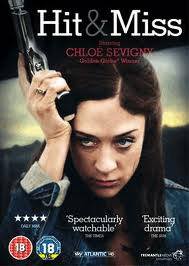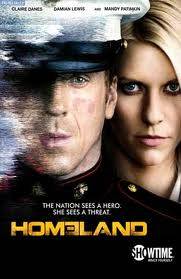New TV Heroines Resemble Male Psychopaths
June 2, 2012

(Chloe Savigny, star of "Hit and Miss.")
"Mia is a transsexual saving up for her gender-changing operation by working as a contract killer, her clinically ruthless day job suddenly messed up by the discovery that she has fathered a 10-year-old boy."
When inmates run the asylum...
by Gerald Gilbert http://www.henrymakow.com
(The Independent, May 22)
In his book The Essential Difference, Simon Baron-Cohen, Cambridge University professor of developmental psychopathology, wrote that "the female brain is predominantly hard-wired for empathy".
Not on TV drama they aren't - or not any longer. The modern television heroine is increasingly likely to act like an anti-social, obsessive male.
Or as Danish actress Sofie Grabol famously said to the writers of The Killing when they tried giving her workaholic detective Sarah Lund a love life: "I am Clint Eastwood... he doesn't have a girlfriend."

After Lund, there was the self-medicating bipolar CIA agent Carrie Mathison in Homeland, picking up men in bars for functional sex, a trait shared with Swedish policewoman Saga Noren in The Bridge, a seemingly undiagnosed case of Asperger's syndrome.
It's a trend that is taken to its logical conclusion in Sky Atlantic's first homegrown drama, Hit & Miss (written by Shameless creator Paul Abbott), in which Chloë Sevigny's Mia is both a sociopath and the owner (albeit reluctantly) of a penis.
Mia is a transsexual saving up for her gender-changing operation by working as a contract killer, her clinically ruthless day job suddenly messed up by the discovery that she has fathered a 10-year-old boy.
Hit & Miss is an unusual concoction - La Femme Nikita meets Shameless, you could say - which perhaps reflects the inspired/random way in which it was created. "I had two concepts that I had been working on and that I fitted together," says Abbott, "the domestic story of a transsexual and a separate drama about a hit man. Singly they didn't add up to a five-course meal, but put together..."
One of the chief delights of Hit & Miss is watching Mia deal with big, bullying men who think she is easy prey. It's a fantasy of female empowerment, although one, as with all of these anti-social heroines, created by men.
And in the case of Saga in The Bridge, like God forming Eve out of Adam's rib, woman was created to complement her male colleague, Martin.
"We started out with Martin," says Hans Rosenfeldt, creator of The Bridge. "We wanted to get away from a Swedish cliché of what middle-aged male police officers are like... We put more female characteristics on him."
It was Saga, Martin's Swedish partner, who was given what might be called the male traits - although you don't have to be a feminist to ask why, for a woman to be single-minded and very good at her job, she has to be in some way autistic.

It's a trend that is taken to its logical conclusion in Sky Atlantic's first homegrown drama, Hit & Miss (written by Shameless creator Paul Abbott), in which Chloë Sevigny's Mia is both a sociopath and the owner (albeit reluctantly) of a penis.
Mia is a transsexual saving up for her gender-changing operation by working as a contract killer, her clinically ruthless day job suddenly messed up by the discovery that she has fathered a 10-year-old boy.
Hit & Miss is an unusual concoction - La Femme Nikita meets Shameless, you could say - which perhaps reflects the inspired/random way in which it was created. "I had two concepts that I had been working on and that I fitted together," says Abbott, "the domestic story of a transsexual and a separate drama about a hit man. Singly they didn't add up to a five-course meal, but put together..."
One of the chief delights of Hit & Miss is watching Mia deal with big, bullying men who think she is easy prey. It's a fantasy of female empowerment, although one, as with all of these anti-social heroines, created by men.
And in the case of Saga in The Bridge, like God forming Eve out of Adam's rib, woman was created to complement her male colleague, Martin.
"We started out with Martin," says Hans Rosenfeldt, creator of The Bridge. "We wanted to get away from a Swedish cliché of what middle-aged male police officers are like... We put more female characteristics on him."
It was Saga, Martin's Swedish partner, who was given what might be called the male traits - although you don't have to be a feminist to ask why, for a woman to be single-minded and very good at her job, she has to be in some way autistic.

"We didn't diagnose Saga," says Rosenfeldt. "But then when we aired the show it turned out that we'd created an Asperger's personality. There are a lot dysfunctional female police officers right now. I guess it's something in the air."
These driven, complicated women are forever being told to go home/take a holiday/get off the case - and they equally invariably ignore this advice.
Sofia Helin is brilliant in The Bridge, while Claire Danes justly won a Golden Globe for Homeland and Chloë Sevigny brings her characteristic fearlessness to Hit & Miss.
They are part of a wider evolution of female characters that really got going with Edie Falco's pill-popping anti-heroine in Nurse Jackie and Mary-Louise Parker's pot-dealing Nancy in Weeds.
Abbott thinks that the boom in dark, complex heroines stems from writers being inspired by watching other writers expand the horizons for their leading female characters.
"Every time you see one work as special as The Killing, it inspires other writers to be more confident with outspoken female roles," he says. Expect more of the same, in other words, and hooray for that.
--
Makow: My reaction to stories like this: God and Satan wagered on mankind. Who would humanity love more? Satan is winning and and will give humanity its due.
These driven, complicated women are forever being told to go home/take a holiday/get off the case - and they equally invariably ignore this advice.
Sofia Helin is brilliant in The Bridge, while Claire Danes justly won a Golden Globe for Homeland and Chloë Sevigny brings her characteristic fearlessness to Hit & Miss.
They are part of a wider evolution of female characters that really got going with Edie Falco's pill-popping anti-heroine in Nurse Jackie and Mary-Louise Parker's pot-dealing Nancy in Weeds.
Abbott thinks that the boom in dark, complex heroines stems from writers being inspired by watching other writers expand the horizons for their leading female characters.
"Every time you see one work as special as The Killing, it inspires other writers to be more confident with outspoken female roles," he says. Expect more of the same, in other words, and hooray for that.
--
Makow: My reaction to stories like this: God and Satan wagered on mankind. Who would humanity love more? Satan is winning and and will give humanity its due.


No comments:
Post a Comment